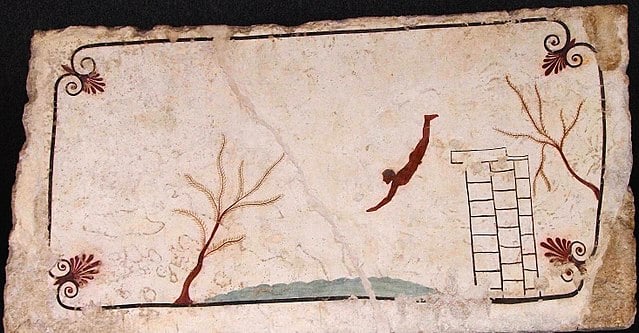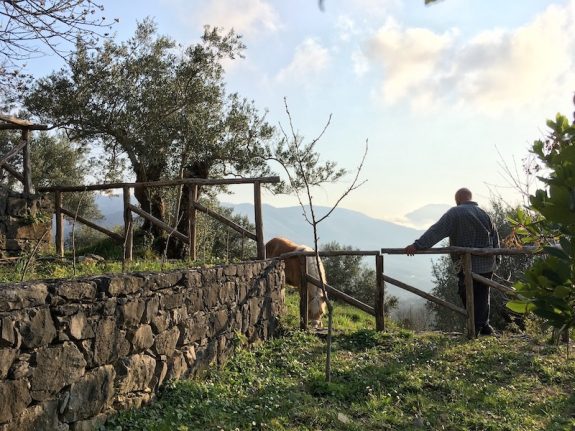“Sorrento? Salento? Salerno? Cilantro?”
Even well-travelled friends in Rome drew a blank when I asked if they’d ever been to Cilento. It’s neither Salento nor Sorrento (nor coriander), though to answer the inevitable next question – “Where’s that?” – Salerno is the closest guess.
READ ALSO:
- The ultimate 2019 travel list: Where to go in Italy this year
- Why Italy's south is better than the north
- Italy's most overrated and underrated destinations
Cilento is the spur that sticks out the western front of Italy’s ‘foot’, just before Campania becomes Calabria. It is indeed part of the province of Salerno, though around a hundred kilometres further south than the well-trodden Amalfi Coast.
Like that more famous stretch, Cilento boasts impossibly picturesque views, pastel villages clinging to hillsides and olive groves tumbling down to turquoise waters; but Cilento is Amalfi’s wilder cousin, not least because much of the area is a vast Unesco-listed national park.
Empty white beaches on the Cilento Coast. Photo: Jessica Phelan/The Local
That park, along with the marine reserves that protect swathes of the area’s coast, has kept Cilento enviably pristine, and relatively overlooked by international tourists drawn to more developed resorts.
At least, that was how I found it on a weekend in early spring, when my partner and I drove the four hours south from Rome to explore the Cilentan Coast. (We’re reluctant drivers, but this is one trip where I recommend taking a car: trains and buses are infrequent and bypass many of the prettiest spots.)
READ ALSO: Weekend Wanderlust: March in Pontone, Amalfi and Ravello
Visiting in the shoulder season you’ll have T-shirt if not beach weather, and you’ll beat the mainly Italian crowds that roll in come July and August.
If you’re approaching Cilento from the north, there’s no excuse not to stop at Paestum, where you’ll find some of the finest Ancient Greek ruins outside Greece. The city was founded by Greek settlers and would become one of the most important in Magna Grecia, the collection of colonies that extended over southern Italy until being absorbed into the Roman Empire.
The Temple of Poseidon (now believed to have been built for Hera or Zeus) at Paestum. Photo: Jessica Phelan/The Local
Paestum was no exception: conquered by a local tribe and then by Romans, it was built and rebuilt by three different ancient civilizations. At the centre, though, its extraordinary temples to the Greek gods have remained standing – on the same scale as the temples at Olympus, but better preserved, in part thanks to a simple building technique that saw the stone blocks joined with dowels instead of mortar, helping them resist centuries of earthquakes.
READ ALSO: Four civilizations in Italy that predate the Roman Empire
We picked our way through them alongside only a few other visitors, watching the sun filter through the columns onto Roman cobbles and grass pinpricked by daisies. It’s not hard to see why Paestum was a favourite of romantic travellers carrying their sketchbooks around Europe on the Grand Tour.
The Temple of Ceres. Photo: Jessica Phelan/The Local
The city’s smaller treasures have been moved inside the compact museum next to the site: monumental friezes recounting Greek myths, painted vases and metal vessels whose handles are rams, snakes and lions.
A glass-walled room houses the prize exhibit: the enigmatic Tomb of the Diver, a painting discovered inside a grave that shows a young man plunging headfirst into water and, symbolically, from life to death.

The ceiling slab that gave the Tomb of the Diver its name. Photo: Cdimaio53 – CC BY-SA 3.0, Wikimedia Commons
From Paestum it’s a half hour’s drive to the start of a string of villages along the coast: Santa Maria di Castellabate, with its pretty stone port and protected waters; Agnone, where the curving bay forms a natural swimming pool; Acciaroli, where Ernest Hemingway stayed and whose fishermen apparently helped inspire The Old Man and the Sea.
We stayed in Pioppi, a place picked almost at random thanks to a beachside holiday apartment with a roof terrace, available and eminently affordable in the off-season. We lucked out, and not just because said terrace was a literal stone’s throw from the sea.
Sea stones drying out in the sun. Photo: Jessica Phelan/The Local
Pioppi, it turns out, is where American doctors first studied and publicized the health benefits of what would come to be known as the Mediterranean diet, the combination of olive oil, fish, fresh produce and legumes that has been claimed to ward off everything from ageing to heart disease to cancer. While the diet itself is very much a local invention, it was the American scientists Ancel and Margaret Keys who (literally) wrote the book on it, while staying in Pioppi and eating the home cooking of a certain Cilentan signora who was employed as their housekeeper. (We’ll come back to her.)
READ ALSO: What is it that makes living in Italy so healthy?
The Keys would spend nearly 30 years of their life in Pioppi, and it’s easy to understand why. It’s the kind of village where you find yourself sneaking glances at estate agents’ windows, just to see, just in case. We would have forgiven ourselves for spending our whole long weekend there, visiting the little Museum of the Mediterranean Diet that showcases the Keys’ work, meandering the trails that lead past many of the native plants they commended growing wild, perhaps even catching a glimpse of tiny oily fish in the crystal-clear sea.
Not a bad view to wake up to in Pioppi. Photo: Jessica Phelan/The Local
But instead we took the car to explore Cilento’s other face: the mountains and rocky gorges that make up its inland. We drove the twisting coastal roads to Palinuro, the town on the southern ‘cape’ of Cilento named for Aeneas’ navigator Palinurus, who according to Virgil fell overboard and washed ashore near the spot; then we cut cross-country.
A 40-minute drive through Mediterranean maquis, the scrubland typical of coasts around the Med, past vertiginous villages and by just-blooming cherries and lemon trees already laden with fruit took us to the Grotte del Bussento, a nature reserve managed by the World Wildlife Fund.
The path to the Grotte del Bussento. Photo: Jessica Phelan/The Local
A gentle hike leads from the closest village of Morigerati down the wall of a canyon, taking you inside the steep caves the reserve is named for and out into sudden green, along the bed of the Bussento river where the microclimate created by stone walls and plentiful water has left every surface covered in bright moss.
If you have the time and stomach for a few more hairpin bends, continue to the Capelli di Venere waterfalls in Casaletto Spartano, where a tributary of the Bussento tumbles over blankety moss and abundant maidenhair (or Venus hair) fern gives the cascades their name.
The dramatic Capelli di Venere waterfalls. Photo: Jessica Phelan/The Local
But enough sights: what about that Mediterranean diet? Back in Pioppi we ran into the one disadvantage of travelling Italy’s small villages in the low season, namely, restaurants with signs saying “Reopening in May”.
We found ourselves with one option: the local pizzeria, heaving on Saturday night and deserted when we returned on Sunday, somewhat shame-faced but too lazy to drive to the next town.
READ ALSO: What makes Neapolitan pizza one of the world's cultural treasures
Even two dinners there allowed us to tick off several of Cilento’s specialities: cacioricotta, goat’s cheese flavoured by fragrant plants in the maquis where the animals graze; sweet pink onions; young olives bashed open by hand with rocks from the sea and preserved with wild herbs, as well as their rich olive oil; and the tomatoes and buffalo mozzarella for which the whole of Campania is rightly famous.
Cavatielli with anchovies and fennel. Photo: Jessica Phelan/The Local
Lunch gave us the chance to sample a few more. At Luna Rossa in Palinuro we tried Paestum artichokes – smaller and rounder than the commoner varieties, and in season in spring – smothered in breadcrumbs, grated cheese and tomato sauce, followed by stubby cavatielli pasta with local anchovies and the fennel that grows wild in Cilento’s maquis.
But the highlight was back in Pioppi, where on a hillside overlooking the beach we stopped at Casa Di Delia, the village’s biggest claim to culinary fame. Delia is none other than the housekeeper to the Keys, and her cucina povera (‘peasant cooking’) found its way into their bestseller, How to Eat Well and Stay Well the Mediterranean Way.
From Delia's garden to her terrace. Photo: Jessica Phelan/The Local
Delia’s restaurant is mercifully open in spring, but only in the afternoon – which is arguably the best time to eat there, given the view from the stone terrace over orchards on one side and the Tyrrhenian Sea on the other.
Weeks later I’m still dreaming of the mixed fish antipasti, starring the house speciality: fresh anchovies slathered in lemon and olive oil and a world away from the gritty preserved variety, alongside deep-fried versions and meaty tuna.
Don't miss the seafood antipasti. Photo: Jessica Phelan/The Local
We just about had time to share the pillowy ravioli stuffed with ricotta and wild sage and a side helping of greens from the garden below before we asked to take two handmade cannoli with us for the car ride back north.
And with cake box in hand, we left. I can’t guarantee Cilento’s health benefits, but its happiness benefits? Those I know are real.
READ ALSO: What can Italy teach the rest of the world about health?



 Please whitelist us to continue reading.
Please whitelist us to continue reading.
Member comments